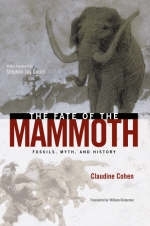
The Fate of the Mammoth
Fossils, Myth, and History
Seiten
2002
University of Chicago Press (Verlag)
978-0-226-11292-3 (ISBN)
University of Chicago Press (Verlag)
978-0-226-11292-3 (ISBN)
From cave paintings to the latest Siberian finds, woolly mammoths have fascinated people across the world for centuries. In this volume the large mammal is reconstructed through its history in science, myth and popular culture.
From cave paintings to the latest Siberian finds, woolly mammoths have fascinated people across Europe, Asia and North America for centuries. Remains of these enormous prehistoric animals were among the first fossils to be recognized as such, and they have played a crucial role in the birth and development of paleontology. In this lively, wide-ranging look at the fate of the mammoth, Claudine Cohen reanimates this large mammal with heavy curved tusks and shaggy brown hair through its history in science, myth and popular culture. Cohen uses the mammoth and the theories that naturalists constructed around it to illuminate wider issues in the history of science, showing how changing views about a single object reveal the development of scientific methods, practices and ideas. How are fossils discovered, reconstructed, displayed and interpreted? What stories are told about them, by whom, and how do these stories reflect the cultures and societies in which they are told?
To find out, Cohen takes us on a grand tour of the study of mammoth remains, from England, Germany and France to Russia and America, and from the depths of Africa to the frozen frontiers of Alaska and Siberia, where intact mammoth corpses have been discovered in the permafrost. Along the way, she shows how paleontologists draw on myth and history, as well as on scientific evidence, to explore the deep history of the earth and of life. Cohen takes her history from the 16th century right up to the present, when researchers are using molecular biology to retrieve mammoth DNA, calling up dreams of cloning them and one day seeing herds of woolly mammoths roaming the frozen steppes.
From cave paintings to the latest Siberian finds, woolly mammoths have fascinated people across Europe, Asia and North America for centuries. Remains of these enormous prehistoric animals were among the first fossils to be recognized as such, and they have played a crucial role in the birth and development of paleontology. In this lively, wide-ranging look at the fate of the mammoth, Claudine Cohen reanimates this large mammal with heavy curved tusks and shaggy brown hair through its history in science, myth and popular culture. Cohen uses the mammoth and the theories that naturalists constructed around it to illuminate wider issues in the history of science, showing how changing views about a single object reveal the development of scientific methods, practices and ideas. How are fossils discovered, reconstructed, displayed and interpreted? What stories are told about them, by whom, and how do these stories reflect the cultures and societies in which they are told?
To find out, Cohen takes us on a grand tour of the study of mammoth remains, from England, Germany and France to Russia and America, and from the depths of Africa to the frozen frontiers of Alaska and Siberia, where intact mammoth corpses have been discovered in the permafrost. Along the way, she shows how paleontologists draw on myth and history, as well as on scientific evidence, to explore the deep history of the earth and of life. Cohen takes her history from the 16th century right up to the present, when researchers are using molecular biology to retrieve mammoth DNA, calling up dreams of cloning them and one day seeing herds of woolly mammoths roaming the frozen steppes.
Claudine Cohen teaches the history of science at the Ecole des Hautes Etudes en Sciences Sociales, Paris. She is the author or coauthor of La Genese de Telliamed: Theorie de la terre et histoire naturelle a l'aube des Lumieres; Boucher de Perthes: Les Origines romantiques de la prehistoire, and L'Homme des origines: Savoirs et fictions en prehistoire. She is currently writing a new book about women in prehistory and preparing (with Andre Wakefield) the first English edition of Leibniz's Protogaea.
| Erscheint lt. Verlag | 16.4.2002 |
|---|---|
| Übersetzer | William Rodarmor |
| Sprache | englisch |
| Maße | 16 x 23 mm |
| Gewicht | 567 g |
| Themenwelt | Naturwissenschaften ► Biologie ► Zoologie |
| Naturwissenschaften ► Geowissenschaften ► Mineralogie / Paläontologie | |
| ISBN-10 | 0-226-11292-6 / 0226112926 |
| ISBN-13 | 978-0-226-11292-3 / 9780226112923 |
| Zustand | Neuware |
| Haben Sie eine Frage zum Produkt? |
Mehr entdecken
aus dem Bereich
aus dem Bereich


